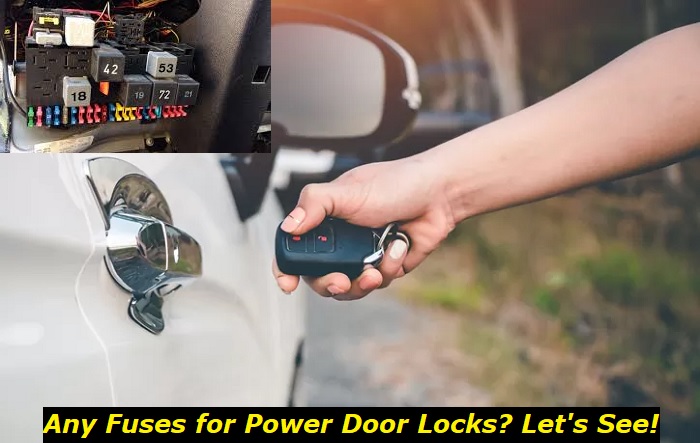Discovering that you are locked out of your car is about as frustrating as it gets. Your power lock system is a modern invention that should make things easier, not harder. The last thing you need is a malfunction in your power door lock to ruin your plans.
Fuse problems highlights
- Level of urgency:medium
- DIY inspection:possible
- DIY repairs:possible
- Can you drive?yes, if it starts
- Price of repairs:$0 - $50
- Ifignored:certainequipment will not be working at all
- Ways to fix:test the fuses, replace the blown fuse

Components of Your Power Door Lock System
A slightly complicated mechanism operates your vehicle's powered car door lock. The position of your door lock is controlled by the car's body controller. The body controller regulates most automatic aspects of your interior.
The controller is responsible for switching the interior lights on when you open the door and shutting them off when you close the door. The warning beep that prevents absent-minded drivers from leaving their keys in the ignition also originates in the body controller.
Your body controller receives the lock or unlocks signal from your key fob. The signal allows the body controller to power the actuator, which is responsible for switching the lock into the lock or unlock position. Your actuator will likely be under the door latch and connected to it by a rod. If your car has a knob peeking near the window, a second rod usually connects the actuator to this knob.
How Your Power Door Lock System Works
- Your body controller receives the signal and transmits it to the actuator.
- The actuator causes a small motor inside your door to begin turning.
- The motor's revolutions will turn a set of spur gears.
- There is a rack and pinion gear set attached to your actuator rod. The gear will drive the rack and pinion gear set, which enables the motor's rotational movement to the linear force needed to lock and unlock your car.
- The small motor will turn in your actuator whenever your door lock is activated. This causes the latch to come down and disconnect from the actuator, thus preventing it from being opened. This security feature protects your car from joyriders, burglars, and thieves.
Signs of A Malfunctioning Power Door Lock System
Here are the most common signs of a failing power door lock system:
- Remote lock and unlock buttons do not function
- Doors do not lock remotely but unlock remotely after you lock them manually
- Driver door does not open passenger doors manually
- Some doors do not lock when the car is parked or in motion
Common Causes of Power Door Lock Malfunctions
Your power door system is much simpler than most systems in your car. When something goes wrong, these are the usual suspects.
1. Blown Fuse
Blown fuses are often behind failing power door locks. An easy way to identify a faulty fuse as the source of your grief is by checking whether the other door locks are functioning properly. It should be relatively cheap and simple whether your fuse has blown because of age or overload. Drivers who wish to save time, energy, and effort rather than money can book an appointment at their dealership or reliable auto repair shop.
Most drivers can replace a blow without professional assistance. You need to locate your power door lock fuse. Your vehicle's user manual will have a precise diagram that points out the location. Most power door lock fuses are located under the hood or the dash. You will also have to buy a high-quality compatible fuse to install in place of the defective one.
2. Key Fob Issues
Sometimes, a power door lock failure may not be caused by a problem in the fuse or relay. The solution could be as simple as replacing the battery in your key fob. If you recently replaced your key fob battery, the problem could be a programming malfunction. Such malfunctions interfere with the signal's transmission.
All you have to do is take your key to the dealership or repair shop for analysis. A mechanic will connect your fob to a computer diagnostic system. If possible, the key fob will be reprogrammed; if not, you will be advised to purchase a new one.
3. Damaged Wiring System
Some drivers face defective power door lock systems that can be convinced to function after several tries. If your system kicks in after repeatedly opening and closing the door or pushing the button, defective wiring is likely to blame. The erratic functioning indicates a loose, damaged, or broken wire that should be fixed immediately.
4. Defective Actuator
When your power door lock fails despite the other door locking properly, you may suffer from a faulty actuator. Replacing a faulty actuator is a complicated task that is best left to the dealership or a well-experienced mechanic.
5. Cold Weather
Most car doors are not moisture-proof. If your area faces extremely cold temperatures may experience power door lock failure when the relay system freezes over. This can be avoided by ensuring you never park your car outdoors during the winter. Some drivers have climate-controlled garages to ensure their favorite toys do not have to suffer freezing over.
How to Diagnose Your Failing Power Door System
If you are an avid DIYer itching to find out which of these problems is affecting your power steering system, this diagnosis procedure will help. Ensure you have the necessary time, tools, and DIY experience to perform these repairs. Let's get started.
When dealing with the power door lock malfunction diagnosis, we zero in on the driver's door because the relay system is typically found in its side panel.
1. Check whether your doors are functioning manually and remotely.
Unlock and lock each of your doors manually. After confirming they are all functional, try locking and unlocking them using the power system. Press the button on your key fob and try unlocking all the locks using your manual driver's lock.
If your remote and manual driver's lock work for all doors except yours (the driver's), it is likely worn. Often the driver's door wears out before the others because of frequent use.
2. Remove Your Door Carpet to Inspect Internal Components
Use the auto trim tool to remove your door carpet. This will involve locating and removing the screws and clips on the carpet. After loosening the screws, pop off the power button knobs. Next, pop and remove the lock on your power handle using a flathead screwdriver or trim removal tools. Place every item you have removed in a central safe location and gently pull off your door carpet.
Peel back the plastic sheet that is covering your door panel. This sheeting usually sheds water from the actuator to prevent water damage during the wet season or a car wash. As you remove the sheet, inspect the lower side of your door panel to ensure the two drain holes are not clogged by debris. Ensure that the components connected to your power handle are firmly connected.
It is not advisable to proceed beyond this point because removing and reinstalling the actuator is an advanced procedure. It is wise to entrust your vehicle to professionals if it requires complex work. Tinkering with your car's components without the necessary tools and skills may create additional problems. These are likely even more expensive to fix when you eventually get around to them.
Cost of Fixing Your Malfunctioning Power Door Lock System
The cost of repairing your power door lock system will depend on your car's make and model, location, the cause of the malfunction, and your mechanic's skill level. On average, you can expect to spend at least $150.
Conclusion
It is wise to rely on your dealership or professional mechanics to fix your failing power door lock system. You should not risk fixing your power door lock system at home because the cost of failure is very high. Repairing your power door lock system incorrectly could make it easier for burglars and car thieves to steal your property.
About the authors
The CarAraC research team is composed of seasoned auto mechanics and automotive industry professionals, including individuals with advanced degrees and certifications in their field. Our team members boast prestigious credentials, reflecting their extensive knowledge and skills. These qualifications include: IMI: Institute of the Motor Industry, ASE-Certified Master Automobile Technicians; Coventry University, Graduate of MA in Automotive Journalism; Politecnico di Torino, Italy, MS Automotive Engineering; Ss. Cyril and Methodius University in Skopje, Mechanical University in Skopje; TOC Automotive College; DHA Suffa University, Department of Mechanical Engineering






Add comment